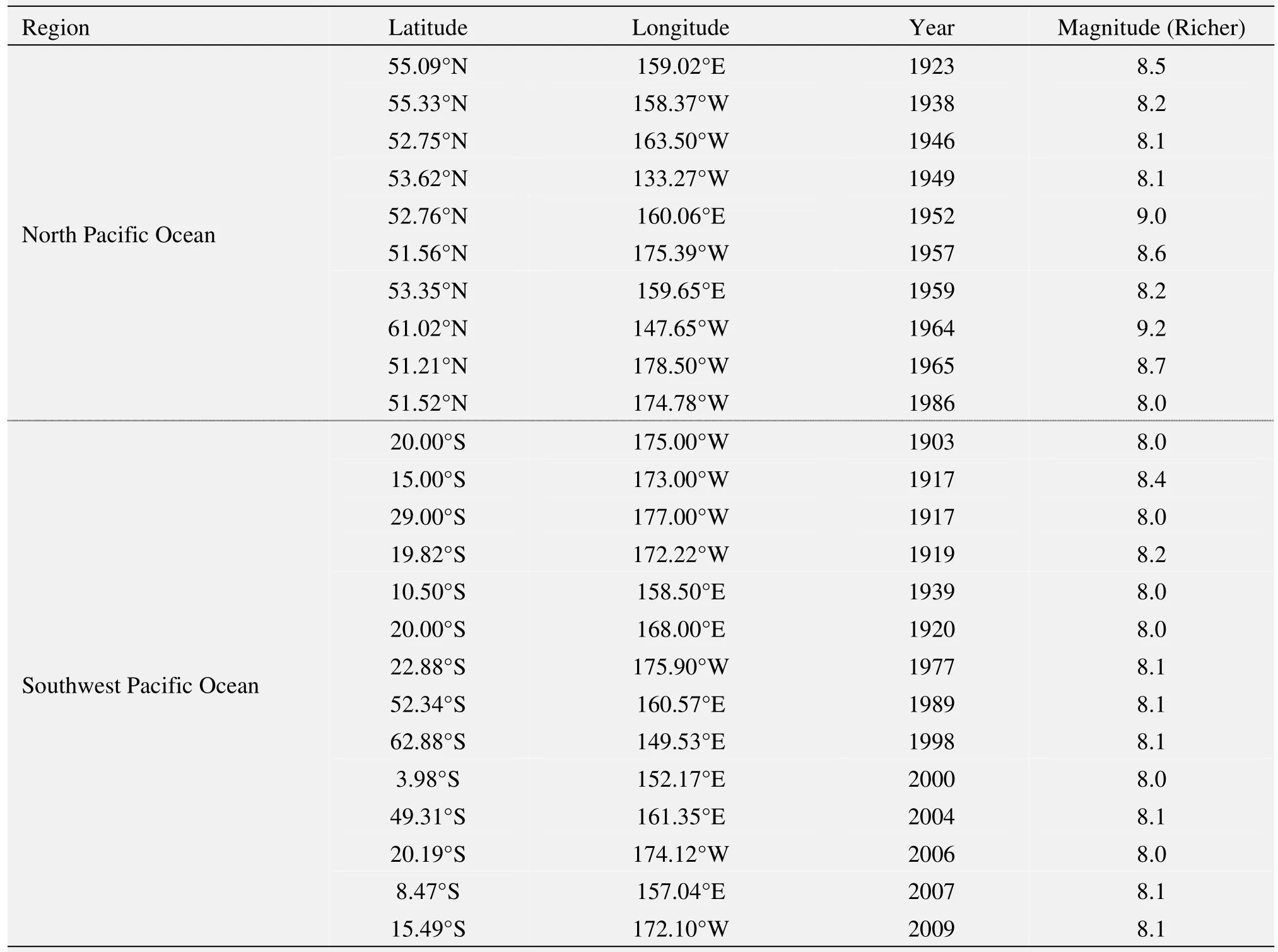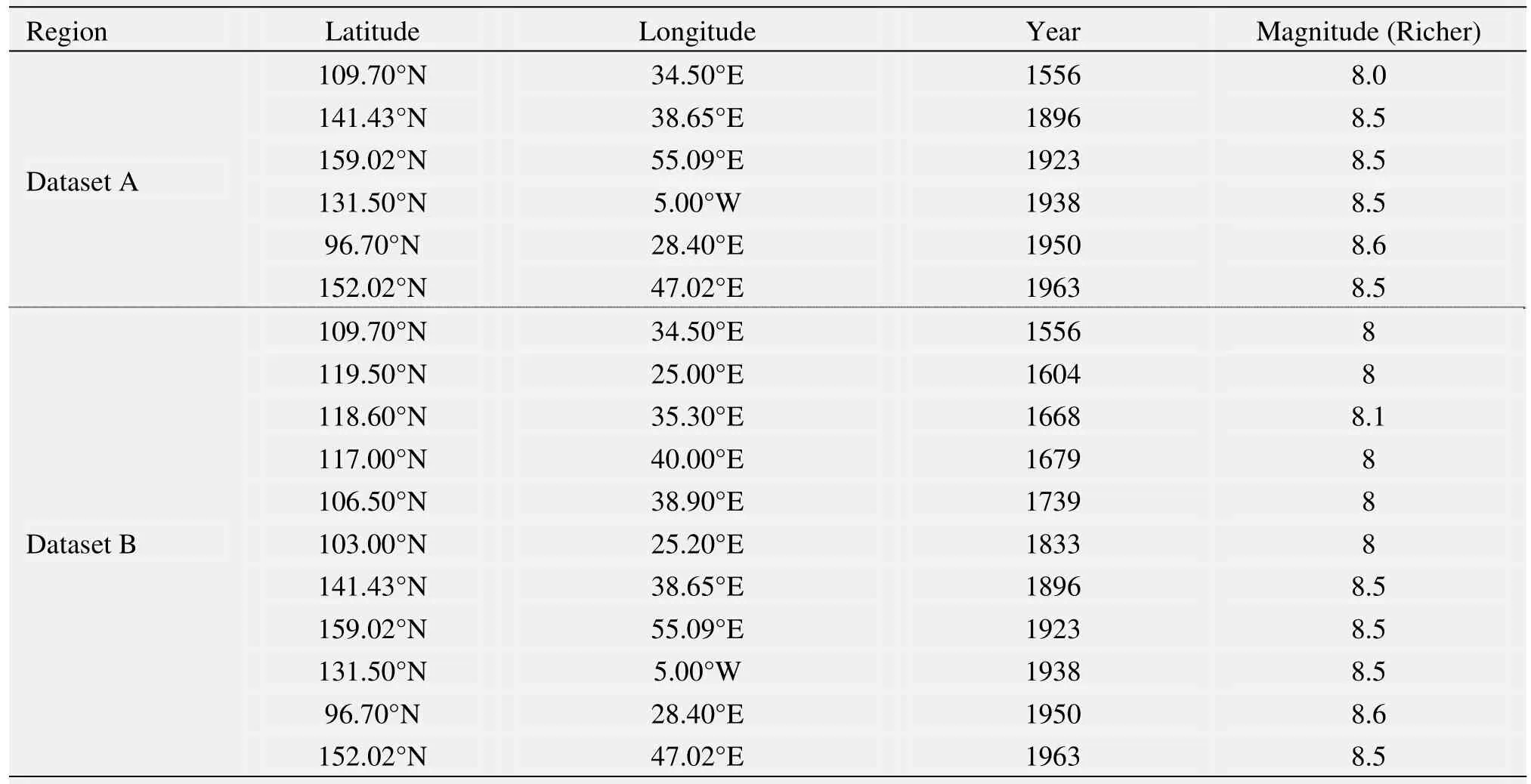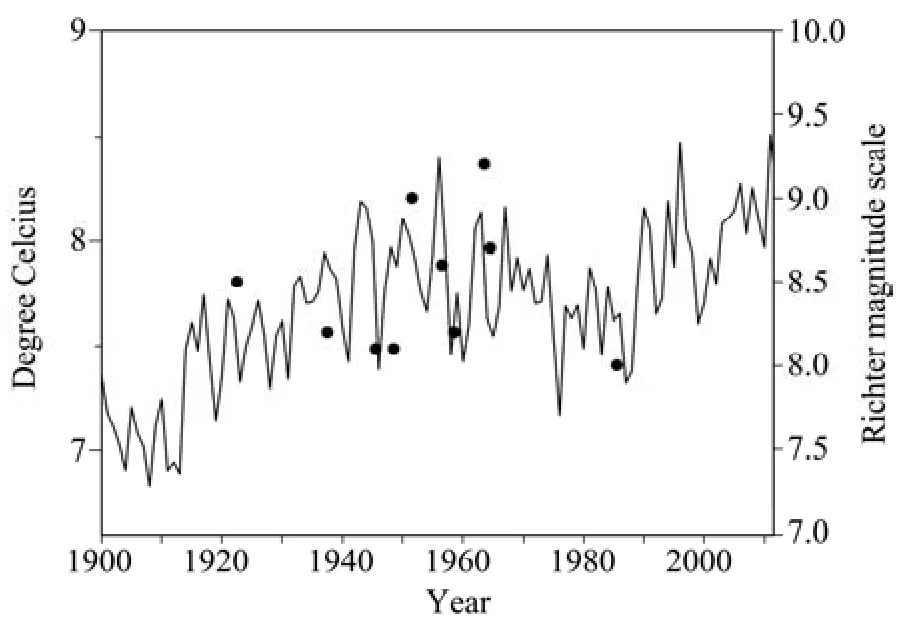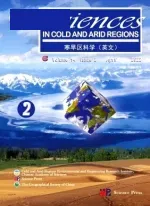Earthquakes as a potential contributing factor to climate change at multi-decadal scale
KeYan Fang , Heikki Seppä
Department of Geosciences and Geography, PO Box 64, 00014 University of Helsinki, Helsinki, Finland
1 Introduction
The sea surface temperature (SST) plays an important role in modulating multi-decadal climate variability via its influences on the large-scale atmospheric circulations. The Atlantic Multi-decadal Oscillation (AMO), the dominant multi-decadal SST mode in the North Atlantic, is closely associated with the temperature and precipitation over much of the Northern Hemisphere. For example, a positive (negative) phase of the AMO results in a warm (cold) Eurasian continent and an enhanced (weakened) Asian summer monsoon by heating the middle and upper troposphere (Wanget al., 2005; Luet al., 2006). In the Pacific Ocean, the Pacific Multi-decadal Oscillation (PDO), the dominant multi-decadal SST mode in the Pacific, is often closely associated with multi-decadal hydroclimate anomalies in East Asia and North America (Mantua and Hare, 2002; Krishnan and Sugi, 2003; Liet al., 2004; Ma, 2007; Fanget al.,2011) and across the globe via large-scale atmospheric teleconnections (Ding and Wang, 2005). The SST patterns can be influenced by the changes of solar forcing, greenhouse gases, volcanic eruptions,and the surface ocean currents driven by winds(Adamset al., 2003; Anchukaitiset al., 2010). However, the variability of these factors is insufficient to explain the multi-decadal-scale features of the AMO and PDO. These multi-decadal variations of SST patterns appear to be modulated by the Thermohaline Circulation (THC). The THC is more conspicuous in the North Atlantic Ocean and is considered as the major driver of the AMO (Enfieldet al., 2001; Latifet al., 2006). Although there are studies which indi-cate that the PDO is likely to be the "reddening" of the El Niño–Southern Oscillation (ENSO) (Newmanet al., 2003), there are also some studies that find significant linkages between the PDO and the THC(Timmermannet al., 2005, Latifet al., 2006; Rashidet al., 2010).
The THC does not only influence global climate via the AMO and PDO; it can also influence climate via atmospheric teleconnections and oceanic waves(Timmermannet al., 2005). The THC can be greatly influenced by freshwater perturbation in the North Atlantic Ocean and strong winds (Timmermannet al.,2005; Latifet al., 2006). Previous studies noted statistical linkages between seismicity and SST (Mei, 1989;Walker, 1999; Guillaset al., 2010; Guillaslet al.,2012), although this is under debate (Hunt, 2000). Sea level changes may trigger earthquakes by changing the pressures on the ocean bottom (Guillaslet al.,2012). Also, increased seismicity may be associated with enhanced heat flow and thus might modulate SST patterns, such as the El Niño pattern (Walker,1999). In addition, earthquakes from the ocean basin or its margins may be associated with oceanic tides that could modulate the SST by bringing up water from the deep ocean (Kachadoorian, 1965; Keeling and Whorf, 1997; Guo, 2002; Singhet al., 2002;Yang D and Yang X, 2008). However, such linkages are likely to be more conspicuous at the inter-annual scale (Guillaslet al., 2012), and factors accounting for the multi-decadal-scale changes of the THC remain unclear. Earthquakes might influence the THC and ultimately influence multi-decadal climate change by modulating the upwelling of the currents of the deep ocean. The purpose of this study was to explore the potential linkages between great earthquakes (M >8.0),particularly in or near the oceans, and multi-decadal variations of the THC and multi-decadal SST patterns(i.e., the AMO and the PDO), as well as their linkages with hydroclimate changes.
2 Data and methods
To explore the relationships between earthquakes and the THC and climate change, we first compared the great earthquakes along the route of the deep currents of the THC since 1900 and then investigated the hydroclimate reconstructions in Monsoonal Asia and historical earthquakes since 1300. As shown in figure 1 and table 1, data pertaining to the great earthquakes since the 1900 along the route of the deep currents of the THC (Broecker, 1991) were obtained from the U.S. Geological Survey (USGS; www.usgs.gov). According to the USGS, most of the great earthquakes in this time period occurred in the pan-Pacific Ocean;therefore, we only focused on the earthquakes along the deep currents of the Pacific branch of the THC. In total, there have been 10 great earthquakes in and near the Bering Sea of the North Pacific Ocean and 14 in and near the Tasman Sea of the Southwest Pacific Ocean since 1900 (Figure 1; Table 1).

Figure 1 Map of the great earthquakes (M >8.0) derived from USGS data (circle) along the route of the THC (Broecker, 1991),and historical earthquakes in East Asia since 1300 derived from data from the USGS (square) and from the China Earthquake Administration (cross). Note that there are very few records of earthquakes near the route of the THC before 1900, and most of the historical earthquakes are derived from the historical documents for inland areas. Detailed information is presented in tables 1 and 2. The deep currents and the surface currents of the THC are also indicated
The AMO index since 1900 was derived from the Extended Reconstruction SST (ERSST.v3b) data with a 2°×2° resolution (Smithet al., 2008). The AMO index was calculated as the residuals between the mean SST averaged over the North Atlantic Ocean(0°–60°N and 0°–80°W), and the SST was averaged over the region 60°S–60°N (Trenberth and Shea,2006). The subtraction from global SST was to minimize the influence of the global warming trend on the AMO and thus highlight the multi-decadal variations.
The PDO index was derived from University of Washington data (http://jisao.washington.edu/pdo/)that was calculated as the averaged SST over the North Pacific Ocean (poleward of 20°N) (Mantua and Hare, 2002). In addition, we averaged the SST from the ERSST.v3b dataset in the North Pacific(40°N–60°N and 170°E–170°W), which covers much of the region that has had great earthquakes since 1900, and the overturning region of the Pacific branch of the THC (Figure 1).

Table 1 Metadata of the great earthquakes (M > 8.0) since 1900 along the route of the THC in the North Pacific Ocean and the Southwest Pacific Ocean
Over the historical period before 1900, both the earthquake data and the PDO reconstruction are less robust. We therefore investigated the historical records for East Asia, where the historical records are relatively sufficient (mainly from China), and the tree-ring based hydroclimate reconstruction for this area (Cooket al., 2010). We analyzed the relationships between seismic activities and abrupt hydroclimate changes since 1300, because the gridded hydroclimate reconstruction covering Monsoonal Asia starts from 1300 (Cooket al., 2010). We employed the Superposed Epoch Analysis (SEA) (Adamset al.,2003; Anchukaitiset al., 2010) to detect potential linkages between hydroclimate responses of East Asia and historical great earthquakes, assuming that other climate forcings with similar time scales can be theoretically canceled out by the averaging process using sufficient data. We generated two datasets from different resources with the event years of great earthquakes. For great earthquakes that occurred within a less than 10-year time span, we used only the middle year as the event year. We focused on the influence of earthquakes on multi-decadal hydroclimate change using 10-year windows (detailed below).
We only considered the earthquakes before the 1970s when the last conspicuous shift of the PDO phase occurred (Mantua and Hare, 2002). Accordingly, the event years of historical great earthquakes(M >8.0) for East Asia derived from the USGS data are herein referred to as dataset A, within which great earthquakes occurred at event years of 1556, 1896,1923, 1938, 1950, and 1963 (Figure 1 and Table 2).We also generated dataset B with great earthquakes(M >8.0) that were recorded by both of the USGS and the China Earthquake Administration(http://www.ceic.ac.cn), which includes great earthquakes that occurred at event years of 1556, 1604,1668, 1679, 1739, 1833, 1896, 1923, 1938, 1950, and 1963 (Figure 1 and Table 2). There are fewer, poorer-quality records of historical earthquakes near oceans compared to inland regions in ancient times,such as in ancient China, because the Chinese ancient civilizations were located in the inland regions and thus there are fewer documented records available in these regions. The hydroclimate reconstructions used herein are the reconstructions of 534 gridpoints of the summer (June–August) Palmer Drought Severity Index (PDSI) with a 2.5°×2.5° spatial resolution from 1300 to 2005, which is termed as the Monsoonal Asia Drought Atlas (Cooket al., 2010).

Table 2 Metadata of the great earthquakes (M >8.0) since 1300 in East Asia of dataset A and dataset B
To detect decadal climate shifts, we first calculated the moving t-test (MTT) based on 10-year windows to transform the reconstructed PDSI data into a time series that indicates the abruptness of any climate shifts. Second, we performed SEA analyses to detect the influences of earthquakes (event years) on the abruptness of climate shifts. The transformed series of abrupt climate changes were sorted into categories on the basis of the event years (year 0) of great earthquakes. We included three years before and six years after each event year into the composites. Finally, we calculated the ratio between the number of years with significant (p<0.005) abrupt climate changes in these composites and the number of years with significant changes.
3 Results
As shown in figure 2, the multi-decadal variations of the AMO and the PDO are similar, except for the period since the 1980s when the AMO is increasing while the PDO is decreasing. It appears that the occurrence of great earthquakes matches better with the phase shifts of the PDO than the AMO. The great earthquakes in the Southwest Pacific Ocean generally correspond to the warm phases of the PDO, while no great earthquake occurred during the period with the lowest PDO indices from the 1940s to the 1970s(Figure 2). In contrast, most of the great earthquakes(7 out of 10) in the North Pacific Ocean occurred during this cold phase of the PDO.

Figure 2 Indices of the AMO and the PDO and the great earthquakes (M >8.0) in the North Pacific and the Southwest Pacific Oceans since 1900.Detailed descriptions of the earthquake data are given in figure 1 and table 1
We further compared the occurrence of great earthquakes and the averaged SST in areas similar to the regions with great earthquakes. Most of the earthquakes occurred in a period with warm SST from the 1930s to the 1960s, particularly in the 1950s and 1960s (Figure 3). Taken together, great earthquakes occurred near the overturning of the deep currents of the THC in the North Pacific Ocean and often correspond to periods with warm SST and cold PDO,whereas great earthquakes along the deep currents of the THC in the Southwest Pacific Ocean often correspond to periods of warm phases of the PDO.
Our SEA analyses showed that decadal/multi-decadal hydroclimate shifts often occur near earthquake years in northeastern Asia, central High Asia, and Southeast Asia (Figure 4). Interestingly, the most significant correlations between PDO and PDSI are found in similar regions (Figure 5). This suggests that the historical earthquakes probably influenced the decadal/multi-decadal hydroclimate shifts in regions that are closely linked to the PDO.

Figure 3 The great earthquakes (M >8.0) in the North Pacific Ocean since 1900 (dot) and the mean annual sea surface temperature (SST) averaged in the similar region(40°N–60°N; 170°E–170°W) (line)

Figure 4 Contour maps of (a) the ratios between years with significant abrupt climate shifts near the years (within a 10-year window) with great earthquakes from dataset A (Table 1) and years with abrupt climate shifts, and (b) the ratios between years with significant abrupt climate shifts near years with great earthquakes from dataset B (Table 2) and years with abrupt climate shifts
4 Discussion
In the North Pacific Ocean, the salty and cold deep currents in the THC are drawn by less-salty and warmer upper-ocean water, leading to a vertical exchange of the deep and surface currents (Walker,1999). This overturning process can cool down the SST in the North Pacific Ocean. The frequent occurrence of great earthquakes in the North Pacific Ocean may be associated with oceanic tides that might modulate the intensity of vertical mixing by bringing up cold water from below (Mei, 1989; Keeling and Whorf, 1997; Guo, 2002; Yang D and Yang X, 2008).The overturning process of the THC is slow and is more likely to have influences on SST at the multi-decadal scale. In other words, the SST may not respond to great earthquakes immediately but may respond to seismic activities with a delay of a few dec-ades. Therefore, a number of great earthquakes from the 1930s to the 1960s were followed by a cooling trend in SST since then (Figure 3). Although the global temperature, including SST, has been increasing sharply since the 1980s toward a peak in the past millennium (Mannet al., 2009), the warming trend of SST in the North Pacific after the 1980s is not as strong as the global trend (Figure 3). This lessened warming trend may be due to the frequent occurrence of great earthquakes from the 1930s to the 1960s. The cooling of the study region in the North Pacific Ocean corresponds to a warm phase of the PDO that is defined as the warming of the East Pacific Ocean and the cooling of the central North Pacific Ocean (Mantua and Hare, 2002). This explains the correspondence between the occurrence of great earthquakes in the North Pacific Ocean and a cold phase of the PDO(Figure 2).

Figure 5 Map of correlations between the summer (June–August) PDO indices (Mantua and Hare, 2002)and the concurrent PDSI data for the modern period 1951–2005
Great earthquakes near the route of the deep currents of the THC in the Southwest Pacific Ocean may also facilitate the vertical mixing of water by bringing up cold water from the deep currents, as indicated above (Kachadoorian, 1965; Keeling and Whorf, 1997;Singhet al., 2002). When deep ocean currents are brought up to the surface in the Southwest Pacific Ocean, the density gradients and thus the velocity of the THC can be reduced. The influence of great earthquakes on the THC over the Southwest Pacific Ocean may be transported to the North Pacific Ocean by generated oceanic waves. This may reduce the overturning over the North Pacific Ocean and thus lead to relatively warm North Pacific SST and a cold PDO due to the reduced exchanges of cold water from the deep ocean. This may explain the opposite relationships of earthquakes in the Southwest and North Pacific oceans with the PDO. That is, the frequent occurrence of great earthquakes in the Southwest (North) Pacific Ocean corresponds to weak(enhanced) overturning in the North Pacific Ocean,leading to warm (cold) SST in the North Pacific Ocean and a cold (warm) phase of the PDO in the following decades.
Considering the great earthquakes in both the Southwest Pacific Ocean and the North Pacific Ocean,we observed similar periodicities between great earthquakes and the PDO. Previous studies also found good agreements between the occurrences of great earthquakes and changes in the PDO during the modern period (Yang D and Yang X, 2008). Phase shifts in the PDO are often accompanied by multi-decadal hydroclimate shifts in Monsoonal Asia (Ma, 2007;Fanget al., 2012). Thus, great earthquakes are linked with hydroclimate changes in Monsoonal Asia via the PDO, which probably explains the findings that hydroclimate changes in regions showing relationships with great earthquakes are similar to the areas showing strong relationships with the PDO (Figure 4).
In summary, our hypothesis is that great earth-quakes near the deep currents of the THC might modulate the THC by changing the vertical mixing of the ocean currents, which modulates the dominant SST pattern and contributes to multi-decadal-scale climate changes. Great earthquakes near the overturning area can accelerate the bringing of cold deep currents to the surface and can cool down the SST at the decadal scale, while great earthquakes away from the overturning area may reduce the density gradients of the THC and thus reduce the overturning. We emphasize that this hypothesis is very preliminary because the instrumental records are not of sufficient length and the quality of the historical records is less than robust.We propose this preliminary hypothesis to add a new perspective on the relationships between climate and earthquakes.
Future studies are needed to address the following caveats. First, the magnitudes of the historical earthquake datasets derived from historical documents are less reliable than modern data. In addition, the historical earthquakes were mostly recorded in inland regions rather than oceanic areas because the Chinese ancient civilizations were not located in coastal regions. For this analysis, we included the historical earthquakes in both inland and seashore areas of East Asia and assumed that historical great earthquakes were often accompanied by other earthquakes in other regions of East Asia, including regions near the oceans. Second, observations on the dynamics of the THC are insufficient for accurate analyses of relationships between earthquakes and the THC. More observations on the velocity of the deep currents of the THC and the overturning process along the route of the THC are needed. And finally, statistical linkages between great earthquakes, the THC, and the dominant SST patterns must be tested in future process-based modeling studies. For example, the influence processes of earthquakes on the velocity of the deep currents of the THC and vertical mixing need to be examined by models.
This research is funded by the Nordic Top-level Research Initiative CRAICC (Cryosphere-Atmosphere Interactions in A Changing Arctic Climate) and the National Natural Science Foundation of China (Nos.41001115 and 41210002).
Adams JB, Mann ME, Ammann CM, 2003. Proxy evidence for an El Nino-like response to volcanic forcing. Nature, 426:274–278. DOI: 10.1038/nature02101.
Anchukaitis KJ, Buckley BM, Cook ER,et al., 2010. Influence of volcanic eruptions on the climate of the Asian monsoon region.Geophysical Research Letters, 37: L22703. DOI: 10.1029/2010GL044843.
Broecker WS, 1991. The great ocean conveyor. Oceanography, 4:79–89.
Cook ER, Anchukaitis KJ, Buckley BM,et al., 2010. Asian monsoon failure and megadrought during the Last Millennium.Science, 328(5977): 486–489. DOI: 10.1126/science.1185188.
Ding Q, Wang B, 2005. Circumglobal Teleconnection in the Northern Hemisphere Summer. Journal of Climate, 18:3483–3505. DOI: 10.1175/JCLI3473.1.
Enfield DB, Mestas-Nuñez AM, Trimble PJ, 2001. The Atlantic multidecadal oscillation and its relation to rainfall and river flows in the continental U.S.. Geophysical Research Letters, 28:2077–2080. DOI: 10.1029/2000GL012745.
Fang KY, Gou XH, Chen FH,et al., 2012. Precipitation variability during the past 400 years in the Xiaolong Mountain (central China) inferred from tree rings. Climate Dynamics, 39(7–8):1697–1707. DOI: 10.1007/s00382-012-1371-7.
Fang KY, Gou XH, Chen FH,et al., 2011. Covariability between tree-ring based precipitation reconstructions in Northwest China and sea surface temperature of Indian and Pacific oceans.Climate Research, 49(1): 17–27. DOI: 10.3354/cr01019.
Guillas S, Day SJ, McGuire B, 2010. Statistical analysis of the El Nino-Southern Oscillation and sea-floor seismicity in the eastern tropical Pacific. Philosophical Transactions of the Royal Society A: Mathematical, Physical and Engineering Sciences,368: 2481–2500. DOI: 10.1098/rsta.2010.0044.
Guillasl S, Day S, McGuire B, 2012. Does the El Niño-Southern Oscillation influence earthquake activity in the eastern tropical Pacific? Climate Forcing of Geological Hazards, 143–165.DOI: 10.1002/9781118482698.ch7.
Guo Z, 2002. The Great Earthquake in ocean and its margin is one of the thermostats for adjusting climate. Northwestern Seismological Journal, 24(3): 287. DOI: 10.3969/j.issn.1000-0844.2002.3903.3018.
Hunt AG, 2000. Comment on "Seismic predictors of El Niño revisited". Comment on an atmospheric stochastic trigger for El Niño. Eos Transactions American Geophysical Union, 81(24):266–272. DOI: 10.1029/00EO00194.
Kachadoorian R, 1965. Effects of the Earthquake of March 27,1964, at Whittier, Alaska. U.S.. Government Printing Office,Wangshington D.C..
Keeling CD, Whorf TP, 1997. Possible forcing of global temperature by the oceanic tides. Proceedings of the National Academy of Sciences of the United States of America, 94: 8321–8328.DOI: 10.1073/pnas.94.16.8321.
Krishnan R, Sugi M, 2003. Pacific decadal oscillation and variability of the Indian summer monsoon rainfall. Climate Dynamics, 21(3): 233–242. DOI: 10.1007/s00382-003-0330-8.
Latif M, Böning C, Willebrand J,et al., 2006. Is the thermohaline circulation changing? Journal of Climate, 19: 4631–4637. DOI:10.1175/JCLI3876.1.
Li CY, He JH, Zhu JH, 2004. A review of decadal/interdecadal climate variation studies in China. Advances in Atmospheric Sciences, 21: 425–436. DOI: 10.1007/BF02915569.
Lu RY, Dong BW, Ding H, 2006. Impact of the Atlantic Multidecadal Oscillation on the Asian summer monsoon. Geophysical Research Letters, 33: L24701. DOI: 10.1029/2006GL027655.
Ma ZG, 2007. The interdecadal trend and shift of dry/wet over the central part of North China and their relationship to the Pacific Decadal Oscillation (PDO). Chinese Science Bulletin, 52:2130–2139. DOI: 10.1007/s11434-007-0284-z.
Mann ME, Zhang ZH, Rutherford S,et al., 2009. Global signatures and dynamical origins of the Little Ice Age and Medieval Cli-mate Anomaly. Science, 326(5979): 1256–1260. DOI:10.1126/ science.1177303.
Mantua NJ, Hare SR, 2002. The Pacific decadal oscillation. Journal of Oceanography, 58: 35–44. DOI: 10.1023/A:1015820 616384.
Mei CC, 1989. The Applied Dynamics of Ocean Surface Waves.World Scientific Publishing Company, Inc., Singapore.
Newman M, Compo GP, Alexander MA, 2003. ENSO-forced variability of the Pacific Decadal Oscillation. Journal of Climate, 16: 3853–3857.
Rashid HA, Power SB, Knight JR, 2010. Impact of multidecadal fluctuations in the Atlantic thermohaline circulation on Indo-Pacific climate variability in a coupled GCM. Journal of Climate, 23: 4038–4044. DOI: 10.1175/2010JCLI3430.1.
Singh RP, Bhoi S, Sahoo AK, 2002. Changes observed in land and ocean after Gujarat earthquake of 26 January 2001 using IRS data. International Journal of Remote Sensing, 23: 3123–3128.DOI: 10.1080/01431160210127065.
Smith TM, Reynolds RW, Peterson TC,et al., 2008. Improvements to NOAA’s historical merged land-ocean surface temperature analysis (1880–2006). Journal of Climate, 21:2283–2296. DOI: 10.1175/2007JCLI2100.1.
Timmermann A, An SI, Krebs U,et al., 2005. ENSO Suppression due to weakening of the North Atlantic Thermohaline Circulation. Journal of Climate, 18: 3122–3139. DOI: 10.1175/JCLI3495.1.
Trenberth KE, Shea DJ, 2006. Atlantic hurricanes and natural variability in 2005. Geophysical Research Letters, 33: L12704.DOI: 12710.11029/12006GL026894.
Walker DA, 1999. Seismic predictors of El Niño revisited. Eos Transactions American Geophysical Union, 80: 281–285. DOI:10.1029/99EO00202.
Wang Y, Cheng H, Edwards RL,et al., 2005. The Holocene Asian monsoon: Links to solar changes and North Atlantic climate.Science, 308: 854–857. DOI: 10.1126/science.1106296.
Yang DH, Yang XX, 2008. The hypothesis of the oceanic earthquakes adjusting climate slowdown of global warming. Progress in Geophysics, 23: 1813–1818.
 Sciences in Cold and Arid Regions2014年2期
Sciences in Cold and Arid Regions2014年2期
- Sciences in Cold and Arid Regions的其它文章
- The spatial and temporal distribution and characteristics of inorganic ion concentrations of TSP in the Tarim Basin
- The atmospheric circulation patterns influencing the frequency of spring sand-dust storms in the Tarim Basin
- Ecological adaptation of Reaumuria soongorica root system architecture to arid environments
- Role of blowing snow in snow processes in Qilian Mountainous region
- Greenland Ice Sheet surface melt: A review
- A new MODIS daily cloud free snow cover mapping algorithm on the Tibetan Plateau
